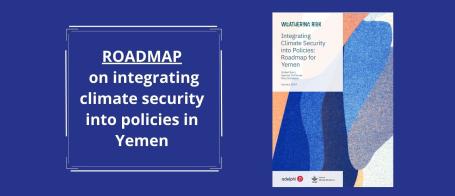Integrating Climate Security into Policies: Roadmap for Yemen
Download the full roadmap here.
Climate and security risks are compounding in Yemen, creating disasters for its population now and in the long term. To manage and mitigate these issues, authorities must ensure that policies consider the relationship between climate change, peace, and security dynamics. Some of the key vulnerabilities Yemen faces include:
- Climate impacts are causing widespread displacement
- The effects of climate change are threatening rural livelihoods, reducing social cohesion
- Extreme weather events are causing enormous amounts of damage to land and property, even causing loss of life
- Security and climate risks are ricocheting off one another in a spiral
Yemen’s government faces critical constraints in tackling climate-related security risks. However, many institutional challenges that could feasibly be overcome are also preventing the mainstreaming of climate security into policy. While addressing these challenges must become a priority for Yemeni policymakers across the institutional landscape, the development of policies that can be implemented requires resources and support from the international community.
The development of this study was enabled by Weathering Risk and is one of four (forthcoming) that build off research undertaken within the framework of the year-long project that adelphi jointly implemented with CGIAR as part of the 'SDG-Climate Facility: Climate Action for Human Security' in the MENA region.
For a summary of the SDG-Climate Facility: Climate Action for Human Security project and an overview of its methodology, findings and recommendations, read Climate, Peace and Security Programming in the Arab States: Considerations for integrated programming in Jordan, Yemen, Iraq and Somalia.
Share on


